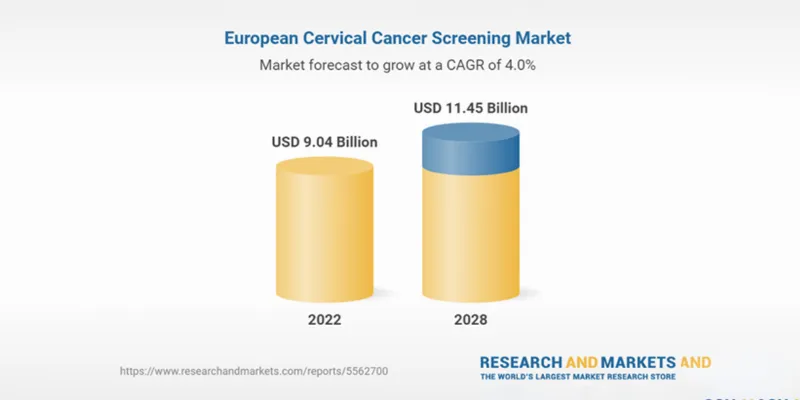EU Cervical Cancer Screening Market is projected to reach US$ 11.4 Billion by 2028

24 October 2023
Europe is witnessing a steady rise in the cervical cancer screening market, with projections indicating a growth to a value of US$ 11.45 Billion by 2028, according to a recent report published on Research and Markets. The market is expected to grow at a Compound Annual Growth Rate (CAGR) of 4.02% from 2022 to 2028.
With over half of European countries implementing comprehensive screening programs, mortality rates from cervical cancer are declining. Key players, including Abbott Laboratories and Roche Diagnostics, are driving advancements, while nations like Germany and Italy emphasize early detection and prevention.
Several European countries have adopted various strategies to detect and prevent cervical cancer at its early stages. A significant number, over half, have rolled out screening programs targeting their entire populations. This proactive approach has contributed to the declining mortality rates from cervical cancer in the European Union, driven by enhancements in both incidence and survival rates.
Key players shaping the European cervical cancer screening landscape include Abbott Laboratories, Hologic Corporation, Siemens AG, Roche Diagnostics, Quest Diagnostics, and Cardinal Health. Their pivotal role in advancing the cervical cancer screening technologies cannot be understated. With a focus on innovation and research, these firms have been instrumental in enhancing the accuracy and efficiency of screening tests, leading to early detection and better patient outcomes.
The market primarily hinges on two major tests: the Pap test and the HPV test. The former involves the collection and examination of cervical cells for abnormalities post-staining, while the latter detects HPV infections from cervical cells. A rising awareness among European women about cervical cancer has seen a significant increase in the uptake of these tests.
Germany, in particular, is observing a notable surge in the Pap test market, reflecting its robust emphasis on women's health. The nation's focus on preventive healthcare has led to the popularity of both traditional Pap tests and the newer HPV tests, given the latter's ability to detect high-risk HPV strains associated with cervical cancer.
Italy, on the other hand, is making strides in the HPV DNA test market. Its healthcare system's accent on early detection and prevention of cervical cancer has spurred the demand for this advanced screening. The Italian market benefits from technological progress, such as automated testing platforms and enhanced sample collection methods.
Government interventions across Europe, including free medical camps, health reimbursement schemes, and awareness campaigns, have been crucial in expanding the cervical cancer screening industry. The upshot is a proliferation of diagnostic centers and service providers dedicated to this cause.
In summary, Europe's cervical cancer screening market is on a growth trajectory, with key nations like Germany and Italy leading the charge. As technological advancements continue to refine screening methods, the future looks promising for early detection and successful intervention in the fight against cervical cancer.
Market Dynamics
Company Analysis: Overviews, Recent Developments, Revenues
- Abbott Laboratories
- Hologic Corporation
- Becton
- Siemens AG
- Roche Diagnostics
- Quest Diagnostics
- Cardinal Health
- Cervical Cancer Diagnostics Market has been covered from 2 viewpoints:
Pap Smear Tests Market
Cervical Cancer Test Population has been covered from 2 viewpoints:
- Pap Smear Test Population
- HPV DNA Test Population
All the 9 Countries Studied in the Europe Cervical Cancer Screening Market Report is as Follows
United Kingdom, France, Germany, Italy, Spain, Sweden, Switzerland, Norway and Netherland.
Europe Cervical Cancer Screening Market, Size, Forecast 2023-2028,
Europe Cervical Cancer Screening Market is projected to reach a value of US$ 11.45 Billion by 2028, according to the publisher. Within Europe, cervical cancer stands as the ninth most prevalent form of cancer affecting women, and it is the second leading cause of cancer-related deaths among women aged 15 to 44 years. Every year, more than 100,000 women in European Union countries receive a diagnosis of cervical cancer, a disease that serves as a significant indicator of the effectiveness of healthcare systems in managing cancer. The survival rates for cervical cancer are influenced by both early detection and the efficacy of treatment. Fortunately, cervical cancer is largely preventable when precancerous cells are identified and treated before they progress. The presence of the human papillomavirus (HPV) is responsible for over 90% of cervical cancer cases, making vaccination against the primary HPV types associated with cervical cancer crucial in reducing its incidence.











Comments
No Comments Yet!